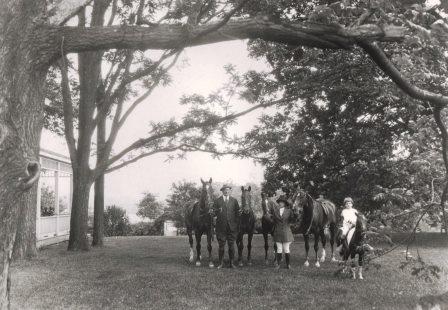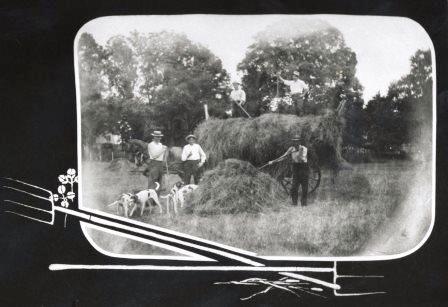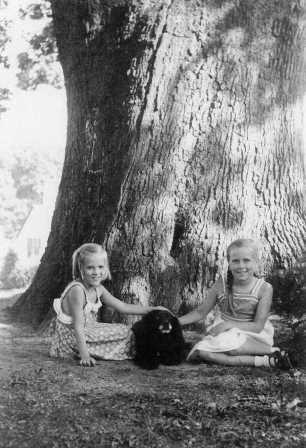A Working Farm
I spent hours in my youth at the Cummings Farm -- watched the pig killing in November, the wheat harvested in July and the stable activity at other times. There I learned to ride a horse, and to see how a large pack of hounds was maintained. -George Winchester Stone, Jr., born in 1907, grew up on Cummings Lane.
When Mrs. Cummings would walk down the street, the turkeys, ducks and geese would follow her. - The Shepherd Street News,a children's newspaper from Chevy Chase, 1976.
As a working farm, the Cummings’ property was a busy place. Other structures on the farm included hay barns, a horse stable, a chicken coop, a corn crib, and a cow shed. Family members were responsible for various tasks, aided by hired hands.
Although two of Mary Cummings’ children, Mary and James, married and moved away to form their own households, the other children continued to live at the farmhouse as adults. Cecilia, Alice and Agnes, along with their brothers Michael and Andrew, were responsible for all the daily chores.
Andrew Cummings Jr. remembered that Alice did most of the cooking and housekeeping work on the farm, and Agnes was responsible for keeping the chickens:
The chicken yard was down behind the house…. She had a nice chicken house, places where the chickens could lay eggs, boxes on the back and roosts built in, windows you could open and close, and a big food bin outside where she'd put cracked corn and various other food for the chickens.
Alice also raised other types of fowl, including turkeys, ducks, and guinea hens.
After college, Michael managed the farm until his early death in 1917. He was also well known as a sportsman and hunter, a member of the Columbia Athletic Club and the Columbian University football team. According to his obituary, he was “the best clay pigeon shot in the east.”
The youngest of the Cummings family, Andrew Joseph “Cy” Cummings, also considered himself a farmer, although after college, he served as a state legislator and he later became the President of the Laurel Racetrack. He married Zelpha Contner in 1914, and they lived at Pleasant Grove, along with their son, Andrew J. Cummings, Jr. Zelpha helped Alice with the housekeeping and joined Cy in caring for their horses. Both Cy and Zelpha were ardent horse riders, and their horse barn reflects this. Andrew Jr. described it: “There were about six stalls and five box stalls. It was a big stable and it had a big loft upstairs. We used to fill it up with hay.”

And it was my job to drive that cart, to fill the barrel up and take it down to the engine. They had a hose they would stick down in the barrel and the engine would suck it out. Suuuurp!

The Cummings always had several hired hands, and Andrew Jr. remembered two men, one white and one black, who lived and worked on the farm. They helped with the farm work, but also with tasks like keeping the water pump working at the farm house and mowing the lawn.
Suburban Lots Begin to Surround the Cummings Farm
When Harry Martin began sub-dividing and developing his “additions” to Chevy Chase adjacent to Pleasant Grove and the Cummings farm land, Alice Cummings bought several lots from him -- the last two on the southeastern side of Cummings lane. Many years later, in 1947, after the Cummings farm was sold, her sister Agnes built a new home there.
…My Aunt Alice bought two lots and a part of a third here. I guess they were just sort of the tail end, and she bought them, probably because they bordered on the farm place. When she died, she left them to my Aunt Agnes, and when we sold the farm, my Aunt Agnes built this house [at 3406 Cummings Lane, in Martin’s Additions]. She left it to me when she died. She was a maiden lady. Ida [Ida Orme, Andrew Cummings, Jr.’s wife] and I moved in and took care of her after the house was completed.
In 1947, the the Cummings family sold the last 30 acres of the farm, including Pleasant Grove. It was sold to a real estate broker, and then sold again to the property developers Camalier and Crosby, who extended Cummings Lane and developed what is now known as Chevy Chase Manor.
The Cummings farmhouse was sold by the developers to the Miles family in 1947. Rufus and Nelle Miles lived at the house with their daughters Barbara and Mary until 1967. That year, the Meisel family moved to the house; Mrs. Jean Meisel, a noted artist, continues to live there today.
Although originally surrounded by farmland, Pleasant Grove is now known by a suburban street number, 3609 Cummings Lane. It does not face the street – a clue that it was built long before the Chevy Chase Manor residential development. The window shutters and the wrap-around porch are gone, but the large double lot still has many of the original trees.
Family photographs from the Miles family, taken in the 1950s and '60s, show the white oak tree still standing, and many other trees surrounding Pleasant Grove. Interior photographs taken with the permission of Mrs. Meisel in Spring 2013 show the generous proportions of the dining room and the long living room, once two different parlors, along with the fireplaces that once held the Latrobe stoves.
In his 1986 CCHS oral history interview, Andrew J. Cummings, Jr. remembered the attachment that everyone in his family had to this house and the farm. The photographs on this page, as well as the following page, help us understand why that was true for the Cummings family as well as the Miles and the Meisels. Before it was struck by lightening in the 1960s, the great white oak tree was a favorite place for a family photograph.
Photos by the great white oak tree:
The Cummings family in the 1920s and the Miles children in the 1950s.

By the white oak, c. 1922 or 1923. Andrew J. Cummings, Sr., Zelpha L. Cummings, and Andrew J. Cummings, Jr. From a print lent by Andrew J. Cummings, Jr. CCHS 1988.15.04. 
The Miles children, Barbara and Mary, in front of the white oak, in the 1950s, when their family owned Pleasant Grove. Donated by Mary Miles Patten, CCHS 2013.06.05.


